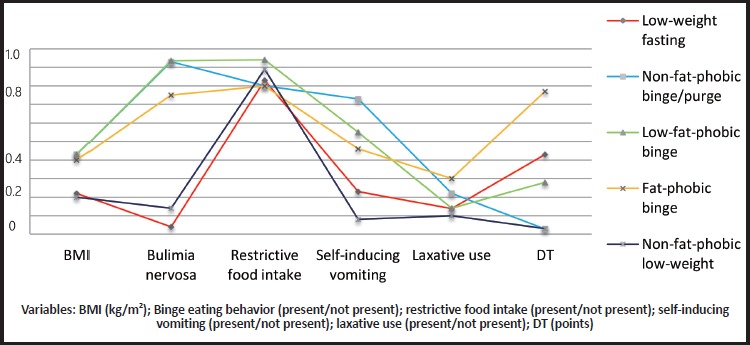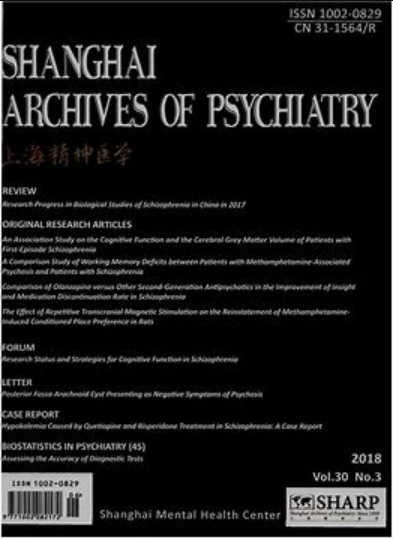上海地区中国饮食失调患者的潜在阶层结构。
引用次数: 2
摘要
背景:饮食失调与文化有关,东西方患者的临床症状不同。因此,在即将发布的ICD-11指南中,喂养和饮食失调对中国患者的有效性尚不清楚。目的:探讨中国饮食失调患者的潜在阶层结构及新版ICD-11指南中饮食失调部分在中国的跨文化效度。方法:对2010 - 2016年在上海市精神卫生中心就诊的379例饮食失调患者采用EDI问卷和自行编制的问卷进行评估。使用SPSS 20.0进行数据录入和人口统计数据分析,使用Latent GOLD进行潜在剖面分析。结果:根据潜在谱分析结果,进食障碍患者被分为5类:低体重禁食类(23.1%)、非脂肪恐惧症暴食/清除类(21.54%)、低脂肪恐惧症暴食类(19.27%)、脂肪恐惧症暴食类(19.27%)和非脂肪恐惧症低体重类(16.76%)。在提取的临床症状中,体重指数(BMI)、暴食行为、自我诱导呕吐、通便药使用和恐脂意见存在显著差异;而在限制性食物摄入方面没有显著差异。结论:基于临床症状,中国进食障碍患者存在5个潜在的分类,与ICD-11中进食进食障碍的诊断分类相一致。然而,在改善饮食失调患者对脂肪的恐惧看法和明确中国人群的BMI瘦标准方面,还需要进一步的工作。本文章由计算机程序翻译,如有差异,请以英文原文为准。


The Latent Class Structure of Chinese Patients with Eating Disorders in Shanghai.
Background Eating disorder is culture related, and the clinical symptoms are different between eastern and western patients. So the validity of feeding and eating disorders in the upcoming ICD-11 guide for Chinese patients is unclear. Aims To explore the latent class structure of Chinese patients with eating disorder and the cross-cultural validity of the eating disorder section of the new ICD-11 guide in China. Methods A total of 379 patients with eating disorders at Shanghai Mental Health Center were evaluated using the EDI questionnaire and a questionnaire developed by researchers from 2010 to 2016. SPSS 20.0 was used to enter data and analyze demographic data, and Latent GOLD was employed to conduct latent profile analysis. Results According to the results of latent profile analysis, patients with eating disorder were divided into five classes: low-weight fasting class (23.1%), non-fat-phobic binge/purge class (21.54%), low-fat-phobic binge class (19.27%), fat-phobic binge class (19.27%), and non-fat-phobic low-weight class (16.76%). Among the clinical symptoms extracted, there were significant differences in Body Mass Index (BMI), binge eating behavior, self-induced vomiting, laxative use and fat-phobic opinion; while there was no significant difference in restrictive food intake. Conclusions Based on the clinical symptoms, there are five latent classes in Chinese patients with eating disorder, which is in accordance with the diagnostic categories of feeding and eating disorder in ICD-11. However, further work is needed in improving the fat-phobic opinion of patients with eating disorder and clarifying the BMI standard of thinness in the Chinese population.
求助全文
通过发布文献求助,成功后即可免费获取论文全文。
去求助
来源期刊
自引率
0.00%
发文量
2341
期刊介绍:
Shanghai archives of psychiatry (bimonthly) was founded in 1959 and is sponsored by Shanghai Mental Health Center. The journal is aimed at mental health workers across the country, including psychiatrists and nurses, clinical psychologists, social workers, and people who are committed to the cause of mental health. It focuses on reporting clinical research results and practical experience in the field of psychiatry, and introduces the latest knowledge in psychiatry and related fields. The columns include monographs, case reports, clinical case discussions, reviews, mental health and law, and debates and discussions.

 求助内容:
求助内容: 应助结果提醒方式:
应助结果提醒方式:


